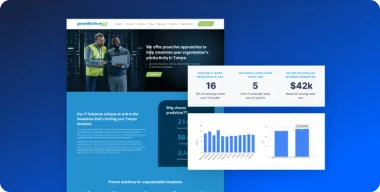Facebook is the world’s largest social network, home to billions of people and businesses, whether they’re flipping through recent updates at lunch or checking up on old classmates after dinner. This ubiquity makes Facebook a prime target for small and medium-sized businesses – allowing you to reach a huge segment of your target audience on every one of their devices.
Facebook’s advertising features tap into the core demographics available on the site, including custom audience definitions, core audience targeting, and lookalike audiences to match with your competitors or publications. You can create ads designed to get users to message you, visit your website, complete a form, install an app, watch a video, or visit an online store. All of that means an incredibly flexible resource that can help grow your business.
Facebook’s advertising allows you to target people based on interests, ensuring that users see ads that are most relevant to them, and it has a number of platforms on its network to tap into – including the core site, Messenger, Instagram, and their expanded audience network. Combined with geographic targeting, it’s a powerful resource for targeting local prospects.
You can use this combination of features to get your brand in front of the right people at the right time. It’s why Pronto offers a comprehensive Facebook Advertising service, built from the ground up to support you in growing your brand, reaching your target audience, and generating new leads.
Common Misconceptions About Facebook Advertising
Before diving into how you can use Facebook’s ad platform, let’s look at some of the most common misconceptions about the platform.
- Business Owners Aren’t on Facebook – It’s common to assume that business owners aren’t on Facebook and won’t see your ads, but a recent study of internal insights at Facebook showed that business decision makers spend 74% more time on the site than other users. They are twice as likely to be a daily active user and 1.9 times more likely to have been active in the last week.
- Facebook Advertising Only Works for B2C Businesses – Even if you’re a B2B business, you are still selling to people. You have to influence decision-makers and that starts by getting out in front of them. Facebook advertising can do just that.
- Facebook Advertising is Expensive – Facebook is still relatively inexpensive compared to other platforms like LinkedIn. While allocating a monthly ad budget to Facebook might seem intimidating, you must always compare it to the lifetime value of a new customer. If you spend $1,000 per month on advertising and are able to pull in $2,000 or $3,000 in new business, it’s not an expense you’ll want to avoid.
How to Setup and Manage a Facebook Advertising Campaign
Pronto’s Facebook advertising service is designed to follow best practices that optimize ad spend and drive results. These are the specific steps we follow when setting up a new campaign for our clients.
Step 1 – Determine Marketing Goals
The first step in building any marketing campaign is to define the goals of that campaign. This is especially true when preparing to invest money in a Facebook advertising campaign.
Ask yourself what you really want to get out of this effort. Do you want local people to better know your products and services, are you interested in getting new visitors to your website, or is your goal solely to get more leads on board for your sales team to follow-up with? Take the time to clearly define what success looks like now as it will help to build your campaign.
Step 2 – Campaign Planning & Setup
The next step is to create your campaign in Facebook’s Advertising Tool, the Facebook Ads Manager.
Start by defining your marketing objective:
- Awareness – Focusing on reach or getting your brand seen.
- Consideration – Driving traffic, boosting post engagement, or getting people to install something or fill out a form.
- Conversion – Focusing on hard sales and measurable results.
Next, you need to define your target audience. Facebook offers several options for this.
Location should be specific to your service area, and your age and gender guidelines should match the demographics of your target decision makers. Interests are a bit more vague and can include everything from job titles to specific things they have mentioned or liked on Facebook. Behaviors may also include specific Pages they have followed or people they have engaged with.
Facebook’s core audience targeting is incredibly useful, but you may have an even more fully defined audience you want to use. Custom Audience can be used for targeting for three potential sources:
- Website visitors – Using a snippet of code installed on your website, Facebook can show retargeted ads only to those people who have visited your site.
- Engagements – You can choose to show ads only to those people who have followed your page or engaged with specific content you’ve published.
- Database – If you have a database of users you can cross check it against Facebook targeting to further narrow your audience.
Finally, there is the lookalike audience targeting option, that allows you to create a group of people that share the same characteristics of your existing clients, website visitors or people who have engaged with your content.
Once you’ve defined your audience, the next step is to create ads for your new campaign. Pronto does this by preparing copy that gets people’s attention, making sure the ad resonates with the viewer. We make sure the quality of the images and copy comply with Facebook policies so the ads will run smoothly. For example, Facebook requires that only a certain percentage of an ad image contains text.
Next, we prepare landing pages where people will be sent if they click on an ad in a Facebook campaign. We encourage people to go to our clients’ websites, so they can see services, promotions, testimonials, and awards, all things that help make the decision to contact or sign up for the service.
The recommended conversion point is often a lead magnet such as an eBook or special promotion which is only available if the user provides their contact details. This requires less of a commitment from the visitor, but with an email, you’re now able to nurture the lead.
The last step of setting up a Facebook ad campaign is to setup conversion tracking. The Pixel tracking code is installed on every page of your website and the Pixel event code is added to your thank you pages to track conversions. Call tracking is another recommendation for most websites, allowing you to see when people call your business from a Facebook ad conversion.
Step 3 – Campaign Launch
Once the campaign is prepared, it is ready for launch. The plan can be implemented, leveraging the given budget to run evenly throughout the month. To get results, our recommended monthly budget is $1,000 to start. During this process, Pronto conducts in-depth A/B testing to check which ads will get the best results. We check which ad copy or image gets the most attention and will simultaneously test audiences, budget, placement, landing pages and campaigns to ensure optimal results.
Step 4 – Campaign Optimization
Because ad performance is monitored daily, we can start optimizing and working with results in just a couple of days. We analyse this data and make changes accordingly, which might include:
- Overall Performance Checks – We check for people noticing ads, click rates on those ads, and if the ad costs are too high against our budget.
- Ad Frequency – We check ad frequency with a goal of keeping it under 2-3 points. If the same audience is seeing the same ads more than 3 times, we will stop the ad or change the creative.
- Relevance Score – This is a key metric Facebook uses to measure which advertisers will show up for a given audience. The higher this score, the better your costs per click and the more often your ads will show up.
- CPC and CTR – Cost per click (CPC) may creep up for certain ads, at which point we will pause and make changes to those ads to get better results. Click thru rate (CTR) should be between 1% and 5%.
Step 5 – Reporting
One of the most important factors when spending money on Facebook ads is the reporting – knowing for certain what works and what doesn’t. Once a month, Pronto sends a report of the overall performance of the campaigns. There are many metrics you should evaluate regularly, including clicks, landing page views, video views, engagements, and impressions. The most important metric, however, is the cost per lead.
When we run a lead generation or conversion campaign, Facebook charges per conversion. The actual cost will depend greatly on how the ads are setup and what type of business is running the ads and to who they are running them. Continuous, repeated optimization of Facebook ads is important to ensure these numbers are strong, which is why regular reporting is so important.
Tips for a Successful Facebook Advertising Campaign
A successful Facebook advertising campaign requires constant monitoring of results and testing to improve. Testing of interests, demographics, copywriting, creative, and the calls to action in your ads will help to yield ever better results.
Once you have a strong performing campaign, retargeting can help get people who clicked through but didn’t convert back to your site and in front of your brand again. By using high quality images and relevant materials in your ads, you can create a powerful marketing message that works better to attract your target audience, boost your relevance score, and reduce your cost per click.
To learn more about our Facebook Advertising service, contact us today and discuss how you can get started.




